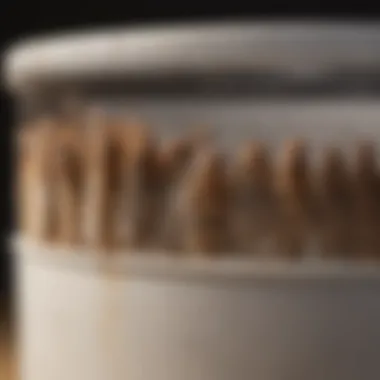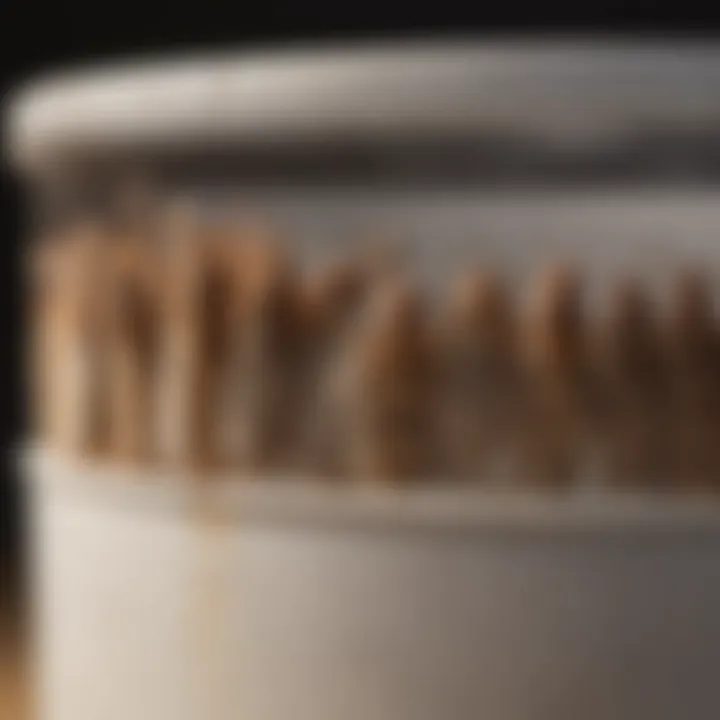Mastering Moth Control in Your Kitchen


Intro
Moths in the kitchen represent more than just an aesthetic issue; they are a potential threat to food safety and overall hygiene. Understanding the intricacies of these pests is crucial for any household looking to maintain a clean and secure culinary environment. This article aims to dissect the moth problem, presenting an array of insightful information from identification to control methods. By the end, readers will be equipped with practical strategies tailored to address this issue effectively.
Understanding the Pest
Identification
Identifying moths is the first step toward effective pest management. The most common insect types found in kitchens include the Indian meal moth, pantry moth, and the jerusalem moth. Each variant thrives in different environments and has unique characteristics that make identifying them vital. The Indian meal moth, for example, has a distinctive reddish-brown color with a wingspan of approximately 12-20 mm. Observing these attributes can help homeowners pinpoint an infestation early, enabling a timely response.
Life Cycle
Moths undergo a fascinating life cycle. It consists of four key stages: egg, larva, pupa, and adult. Females typically lay numerous eggs in dry food products, such as grains or nuts. Once the eggs hatch, they turn into larvae that consume food products voraciously. This stage lasts a few weeks, depending on environmental conditions, and can cause significant damage before progressing to the pupal stage. Understanding this cycle empowers homeowners to recognize the window of opportunity for intervention, as targeting moths in their larval stage is often the most effective approach.
Moth infestations, if left unchecked, can compromise food integrity as larvae feed on pantry staples.
Pest Prevention Strategies
Environment Modification
Proactive strategies can significantly reduce the risk of moth infestations. Environment modification is essential and involves altering areas where moths might breed. Ensuring that foodstuffs are stored in airtight containers minimizes access to moths, thus disrupting their reproduction cycle. Regularly cleaning kitchen spaces where food may accumulate is also advisable, as it removes potential habitats for moth eggs and larvae.
Physical Barriers
Implementing physical barriers is another vital aspect of prevention. Installing screen doors and sealing cracks and crevices helps keep moths out of the kitchen. Additionally, consider using traps designed specifically for moths. These can attract male moths using pheromones, interrupting the breeding process. Homeowners should take these preventive actions seriously to maintain a moth-free kitchen environment.
Control Methods
Chemical Control
If a moth infestation occurs, chemical control options are available. Insecticides aimed at pantry moths should be selected with care. Always follow product instructions to ensure safety, particularly in food preparation areas. Organic options are now available and can be a more eco-friendly choice. However, chemical treatments should be the last resort, utilized only when other methods have failed.
Biological Control
Biological control presents an intriguing alternative. This method relies on natural predators or parasites to manage moth populations. Introducing certain insect species that prey on moth larvae can help maintain control without introducing harmful chemicals into the kitchen. This approach entails a longer timeframe for results, but it contributes to a healthier environment overall.
Closure
Foreword to Moth Infestations
Moth infestations in kitchens are not just a nuisance; they represent a significant concern for homeowners. Understanding this topic is crucial for effectively managing and preventing such infestations. Moths, particularly pantry moths, are adept at finding their way into homes and can quickly reproduce if not addressed promptly. A poorly managed moth problem can lead to contamination of foodstuffs, creating risks for health and hygiene.
It is essential to recognize that moths can consume a variety of food products, including grains, dried fruits, and nuts. Knowing the specific types of moths commonly found in kitchens can aid in identifying the problem correctly. This knowledge is beneficial for timely intervention and effective treatment.
The critical benefits of addressing moth infestations include:
- Protecting food safety and ensuring hygiene in the kitchen.
- Reducing stress and frustration associated with pests in the home.
- Preserving the quality of pantry items, thus minimizing waste and saving money.
This article will delve into the various aspects of moth infestations in the kitchen, from understanding the types of moths to implementing practical solutions. It is intended to equip homeowners with the necessary insights and tools to maintain an environment free from these unwelcome pests.
"Prevention is the first line of defense against moth infestations, making knowledge and vigilance key components of effective pest management."
In summary, comprehending the moth problem is a stepping stone towards maintaining a clean, safe, and well-managed kitchen. It underscores the importance of recognizing not only the underlying issues but also the solutions available for managing these kitchen invaders.
Types of Moths Found in Kitchens
Understanding the types of moths commonly found in kitchens is essential in effectively addressing infestations. Each species has distinct behaviors, preferences, and life cycles that impact how they interact with food and kitchen areas. Identifying the specific moth type in your home is the first step towards effective remediation. This section will discuss three prominent moths: the Indian Meal Moth, the Kitchen Moth, and the Pantry Moth. Each species presents unique challenges and solutions. By familiarizing yourself with them, you can devise better strategies for control and prevention.
Indian Meal Moth
The Indian Meal Moth, known scientifically as Plodia interpunctella, is one of the most common kitchen moths. It measures about 1/2 inch long and has a unique coloration—with a grayish-brown exterior and reddish-brown tips on its forewings. This species thrives particularly well in warm, stored food products. Common food sources include grains, cereals, nuts, dried fruits, and even chocolate.
Signs of an Indian Meal Moth infestation include webbing on food packaging and the presence of small larvae in food items. Female Indian Meal Moths can lay hundreds of eggs, which hatch into larvae that feed and grow. They are particularly troublesome due to their capability to infest a wide range of foodstuffs. Therefore, maintaining stringent food storage practices is crucial for hindering their lifecycle.
Kitchen Moth
The Kitchen Moth, or Ephestia kuehniella, is another notable pest that homeowners may encounter. Typically darker than the Indian Meal Moth, these moths have a wingspan of about 3/4 inch. They prefer flour, grains, and mixes, making them especially problematic in baking environments. Kitchen Moths commonly find their way into unopened packages, making them challenging to detect until significant damage has occurred.


To manage Kitchen Moths, regular inspection of foodstuffs and proper sealing techniques are essential. Ensuring food containers are airtight can reduce the likelihood of an infestation. Furthermore, vigilance during grocery shopping helps prevent bringing infested products into the home, which is a critical component in controlling their presence.
Pantry Moth
Pantry Moths, especially Plodia interpunctella, are often observed alongside other species and do not differ considerably in appearance from the Indian Meal Moth. They thrive in dry goods found in pantries, fruiting in environments where food is stored and neglected. Their larvae can cause significant damage, feeding on items like pasta, rice, and even spices.
Detection of Pantry Moths can be tricky due to their small size. However, one common indicator is the presence of larvae in food or the emergence of adult moths around the pantry area. Prompt action is required to address infestations. Always check expiration dates and perform a thorough cleaning when a Pantry Moth presence is suspected. Regularly replacing and storing pantry items can provide an effective ongoing defense against these pests.
"An efficient method to combat moth infestations is regular monitoring. Maintaining clean and organized food storage can significantly reduce the risk of re-infestation."
In summary, recognizing these three moths provides essential insights into maintaining a healthy kitchen environment. Identifying food sources and habits helps inform prevention strategies and can significantly aid in eradicating infestations.
Understanding Moth Behavior
Understanding the behavior of moths is crucial in addressing infestations effectively. This section explores their life cycle and feeding habits. Knowledge in these areas allows homeowners to anticipate problems before they escalate. It also aids in choosing the most appropriate solutions, thus minimizing the risk of recurrent infestations.
Life Cycle of Moths
Moths undergo a complete metamorphosis, which includes four distinct stages: egg, larva, pupa, and adult. The duration of each stage can vary based on environmental conditions such as temperature and humidity.
- Egg Stage: The female moth deposits eggs in dark and secure locations, typically near food sources. These eggs may take three to ten days to hatch, depending on the species and conditions.
- Larval Stage: Once hatched, larvae (caterpillars) emerge. This stage is the most destructive as larvae feed on food sources. They can remain in this stage for several weeks, growing and molting several times before pupation.
- Pupal Stage: After sufficient feeding, the larva will find a secluded place to spin a cocoon. During this time, they undergo transformation. This stage can last from a few days to several weeks.
- Adult Stage: Eventually, an adult moth emerges. These adult moths primarily seek mates and reproduce, continuing the cycle. Recognizing this cycle helps in timing intervention tactics effectively, especially during the larval stage when they cause the most damage.
Feeding Habits and Preferences
Moth feeding habits vary by species but generally revolve around stored food products. Most kitchen moths are attracted to grain-based foods, dried fruits, and nuts. Their preferences can also lead them to sweets and dog food.
Some key points regarding their feeding behavior are:
- Preference for Starch and Sugar: Moths tend to favor foods high in sugar or starch.
- Tendency for Contaminated Food: They are also drawn to stale or contaminated food.
- Nocturnal Feeding: Many moths are more active during the night, making detection difficult.
Understanding these feeding preferences will allow for better storage practices. Ensuring that food is sealed in airtight containers helps in reducing accessibility. Moreover, regular inspections of pantry items can aid in early identification of moth presence, minimizing the impact of an infestation.
"By knowing the behavior of moths, we can take proactive measures to prevent infestations before they occur."
In summary, grasping the life cycle and feeding habits of kitchen moths equips homeowners with the necessary tools for effective prevention and control. This knowledge not only simplifies management strategies but also enhances food safety in kitchen environments.
Identification of Moth Infestations
Identifying moth infestations is crucial for maintaining a healthy kitchen. Moths, especially when they settle in food storage areas, can pose significant risks to both hygiene and food safety. Timely recognition of these pests allows for swift action, minimizing damage and preventing further complications. When homeowners can discern signs of infestations and understand the distinctions between moths and other pests, it facilitates a more effective response to pesticide applications and safe removal of contaminated goods.
Signs of Moth Presence
Recognizing signs of moth presence can be subtle but essential. Look for tiny webs, often found in corners or on stored food items, which indicate the presence of caterpillars. Adult moths, such as the Indian Meal Moth, are typically seen flying near light sources. Some additional indicators include:
- Larvae: Small, often white or light brown caterpillars can be found in food pantries.
- Frass: Tiny remnants resembling grain or sand, often discovered near infested food.
- Infestation in Packaging: Examine boxes, bags, or containers. Open packages may reveal clumping food particles.
"The earlier you detect moths, the easier it is to manage an infestation."
In cases of heavy infestations, you may also find adult moths resting on walls or ceilings, a signal of an established problem. Understanding these indicators early can save time and resources in addressing the issue effectively.
Differences Between Moths and Other Pests
Distinguishing moths from other common kitchen pests is vital for proper identification and control. Moths can be confused with flies or beetles due to their size and coloring. However, certain key characteristics help differentiate them:
- Body Shape: Moths have a more slender and elongated body compared to beetles. Flies typically have a more rounded physique.
- Wings: Adult moths usually have wings that lay flat over their bodies when at rest. In contrast, beetles’ wings hug tightly to their bodies, and flies have a different overall wing structure.
- Behavior: Moths are attracted to light, often fluttering near windows or light fixtures, while other pests may not show this behavior.
It is important to observe these traits closely. Homeowners should document their findings for a clearer perspective before proceeding to control methods. Educating oneself about these differences contributes to efficient pest management and helps in maintaining a sanitary kitchen.
Practical Solutions for Moth Control
Moth infestations in kitchens require effective strategies to regain control. Understanding practical solutions is vital for both prevention and elimination. Addressing these issues ensures that your kitchen remains a safe environment for food preparation. Proper methods can prevent the spread of infestations and reduce the likelihood of future problems. This section explores effective approaches, focusing on preventive measures and removal techniques.
Preventive Measures
Preventive measures are the first line of defense against moth infestations. Implementing these strategies can significantly reduce the chances of an infestation occurring. Several actions can be taken:
- Inspect Foods Regularly: Always check for signs of infestation, especially in dry goods like grains and cereals. Look for small holes, webbing, or larvae.
- Store Food Properly: Utilize airtight containers for food storage. Plastic or glass jars with tight lids help keep moths out.
- Maintain Cleanliness: Regularly clean kitchen areas. Vacuum cupboards and shelves, focusing on corners and crevices where moths may hide.
- Seal Cracks and Openings: Check for gaps around doors and windows. Seal any cracks to prevent moths from entering your home.
- Rotate Stock: Use older food products first to prevent moths from establishing a presence in storages.


These preventive measures not only deter moths but also contribute to overall kitchen hygiene.
Removal Techniques
If an infestation is confirmed, removal techniques become crucial. Timely intervention is essential to minimize the impact on food safety. Here are some effective methods:
- Identify the Source: Begin by locating the source of the infestation. Discard any infested items immediately.
- Thorough Cleaning: Clean the affected areas with warm, soapy water. This removes eggs, larvae, and debris that could harbor moths.
- Pheromone Traps: Consider using pheromone traps. These traps attract and capture male moths, helping to disrupt the breeding cycle.
- Insecticides: In cases of severe infestations, it may be necessary to use insecticides specifically designed for moth control. Follow the instructions carefully and ensure the area is well-ventilated.
Important: Always check product labels for safety guidelines, especially in kitchens.
- Heat Treatment: For clothing or textiles, heat treatment can be effective. High temperatures can kill eggs and larvae. For non-washable items, placing them in a hot dryer for 30 minutes should suffice.
In summary, addressing moth infestations requires a combination of preventive measures and removal techniques. By taking proactive steps, homeowners can maintain a moth-free kitchen and ensure food safety.
Eco-Friendly Pest Control Methods
Addressing moth problems in the kitchen through eco-friendly methods is crucial in promoting both health and environmental responsibility. As households become more aware of the dangers posed by chemical pesticides, alternatives that respect natural ecosystems gain importance. Eco-friendly pest control methods minimize impact on human health and the surrounding environment while still effectively targeting unwanted moths.
Natural Repellents
Natural repellents serve as a first line of defense against moths. These substances, derived from plant materials, help to deter moths without the need for harsh chemicals. Common natural repellents include essential oils like lavender, peppermint, and eucalyptus. When used properly, these oils can effectively disrupt moth activity.
To utilize these repellents, consider the following approach:
- Create a spray: Mix a few drops of essential oil with water in a spray bottle. Shake well and lightly mist areas prone to moth activity. This not only helps repel moths but also leaves a pleasant scent.
- Cotton balls soaked in oil: Soak cotton balls in your chosen essential oil and place them in drawers, cupboards, or food-storage areas. This method provides a steady release of scent over time.
- Herbal sachets: Fill small fabric bags with dried herbs such as rosemary or sage. Placing these sachets in your pantry can act as both a natural repellent and a decorative element.
These natural solutions are not only effective but also safe for families and pets. They support an overall healthy kitchen environment.
Homemade Traps
Homemade traps offer a practical solution for controlling moth populations in the kitchen. They are easy to make and can be composed of simple household items. An effective trap can be constructed using sticky paper or adhesive tape combined with attractants.
- Materials Needed:
- Construction Steps:
- Cardboard or paper
- Cooking oil or honey
- Optional: Essential oils (for added attractant)
- Cut the cardboard into strips or squares.
- Spread a thin layer of cooking oil or honey on one side of the cardboard. If desired, you can add a drop of essential oil to enhance its appeal.
- Place the traps in corners of the kitchen or near food storage locations.
The oils or honey attract moths, making them stick to the paper. Regularly check and replace traps to maintain efficacy.
These traps are non-toxic and provide a good option for those needing to manage moth populations without resorting to commercial chemicals.
The importance of using eco-friendly methods cannot be overstated. They not only safeguard your kitchen but also contribute to a healthier living space for your family.
In summary, utilizing natural repellents and homemade traps addresses moth infestations effectively while aligning with an eco-conscious lifestyle. Implementing these methods allows homeowners to manage pest problems while minimizing their environmental footprint.
Long-Term Maintenance Strategies
Long-term maintenance strategies are crucial for managing moth problems in the kitchen. These approaches ensure that environments remain inhospitable to these pests, therefore reducing the chances of future infestations. A proactive stance not only protects food but also promotes a healthier kitchen atmosphere. A few essential strategies comprise effective storage solutions and regular monitoring practices. These methods create a sustainable approach that benefits all household members in the long run.
Storage Solutions
Proper storage is a key element in preventing moth infestations. It involves utilizing airtight containers that exclude moths and other pests from accessing food items. Glass or plastic containers with secure lids are ideal. These containers not only protect food but also help to keep it fresh.
- Utilize glass jars or plastic bins to store bulk grains, cereals, or snacks.
- Keep opened packages sealed tightly with clips or transferred into airtight options.
- Regularly clean pantry shelves and check for any spills.
- Avoid storing food items in paper or cardboard, as these materials offer little protection.
Adhering to these storage practices can dramatically reduce the risk of moth infestation. Moreover, labeling containers can also help in rotating stock, ensuring older items are used first and reducing food waste.
Regular Monitoring Practices
Continuous monitoring serves as a preventative measure and assists in the early detection of any moth presence. This practice involves routinely checking stored food items and pantry areas for signs of moth activity. Keeping an organized pantry makes this task easier and more effective.
- Schedule periodic inspections of food items, at least once a month.
- Look for webbing, larvae, or adult moths.
- Invest in moth traps made of sticky adhesive, which can help monitor and catch any adult moths.
Maintaining a schedule for these checks encourages vigilance against unwanted pests. Identifying any potential issues quickly leads to appropriate actions to eliminate them, keeping the home safe.
"An ounce of prevention is worth a pound of cure." Regular monitoring is not just a strategy; it becomes a habit that ultimately saves time and resources.


Ending
In this article, we delved into the complexities and nuisance of moth infestations in kitchens. Understanding the significance of addressing moth problems is vital for maintaining food safety and hygiene. Unchecked infestations can lead to food contamination and considerable waste.
A key takeaway is the importance of early detection. Identifying the signs of moth presence swiftly helps in minimizing potential damages. Knowing the specific types of moths can also influence the choice of targeted treatments.
Summary of Key Points
- Types of Moths: Understanding the differentiation between Indian Meal Moths, Kitchen Moths, and Pantry Moths can aid in tailored pest control strategies.
- Behavioral Insights: Grasping the life cycle and feeding habits of moths enables the implementation of preventative methods effectively.
- Identification Techniques: Recognizing signs of infestations helps in timely interventions and remediation efforts.
- Control Measures: Practical removal techniques are critical, alongside eco-friendly pest control options that respect health and environmental standards.
- Maintenance Practices: Long-term strategies include proper storage solutions and regular monitoring to prevent re-infestation.
By synthesizing these points, one gains a comprehensive understanding of how to handle individual moth issues. This ensures cleanliness and safety within kitchen spaces, ultimately enhancing the quality of life for housewives and homeowners alike.
"Effective pest control is not just about elimination, but prevention and maintenance."
The knowledge shared here equips readers to take informed actions against moth infestations, securing a well-maintained and safe kitchen environment.
Commonly Asked Questionss on Kitchen Moths
Understanding common questions related to kitchen moths is crucial for effective pest management. This section provides clarity on significant concerns, helping readers to not only identify the problem early but also to address it efficiently. Knowledge serves as first line of defense against these pests.
How to spot a moth infestation early?
Early detection of moth infestations can prevent major issues in the kitchen. Specific signs can help identify an infestation before it escalates:
- Visible Moths: Spotting adult moths flying around the kitchen is a clear warning signal. They tend to hover near food sources.
- Webs or Larvae: Look for small web-like structures or larvae in food packages. This indicates moth activity.
- Frass: This is the droppings of moth larvae, resembling tiny pepper grains, and can be found near infested areas.
Regularly inspecting food storage areas and maintaining cleanliness can help catch these signs early.
What is the most effective way to eliminate moths?
Elimination of moths requires a systematic approach. Here are effective strategies:
- Cleaning: Begin with thorough cleaning of all pantry surfaces and food containers. Remove all food items, discard any infested packages, and vacuum areas meticulously.
- Sealing Items: Store foods in airtight containers. This will thwart access to any future intrusions by moths.
- Insecticides or Traps: Consider using insecticide sprays specifically designed for moths or non-toxic traps that lure and capture them.
- Natural Remedies: Employ essential oils such as lavender or cedar, which act as natural repellents.
Following these steps will significantly reduce the moth population.
Can moths harm food safety?
Moths can pose a genuine threat to food safety. They do not directly harm food in the same way some pests might. However, the presence of moths often indicates contamination of food products. Here are key points to consider:
- Contamination: Moth larvae can infest food products, leading to contamination and spoilage.
- Health Risks: Consuming food that has been infested by moths can lead to gastrointestinal discomfort. Though rare, ingesting contaminated food is not advisable.
Maintaining strict food safety standards and regular inspections are needed to mitigate these risks.
"Prevention and early detection of moth infestations are the most effective ways to ensure kitchen safety and hygiene."
By grasping the answers to these FAQs, homeowners can move toward a more proactive and informed management of kitchen moths. Being prepared and knowledgeable is essential in keeping a kitchen moth-free.
Resources for Further Reading
Understanding moth infestations, particularly in kitchen environments, entails more than just knowing how to identify and eliminate them. It also requires access to comprehensive resources that can help broaden one’s knowledge and enhance practical knowledge. This section provides useful literary and online resources that enable continued learning about kitchen moths and pest control practices.
Books and websites can significantly contribute to one’s understanding by offering deep insights, up-to-date research, and diverse perspectives. These resources also serve as practical tools for homeowners and housewives seeking to reinforce proper hygiene and food safety measures in their kitchens.
By engaging with well-researched books and credible websites, readers can equip themselves with information that is scientifically sound. This knowledge is vital not just for addressing existing moth problems but also for preventing future infestations. Having a reliable repository of information adds confidence in making informed decisions and implementing effective pest control strategies.
"Knowledge is power. The more you know, the better equipped you are to handle situations effectively."
Books
Several books offer valuable insights into the subject of moth control and pest management. These publications often cover various aspects including identification, life cycle, and ecological impacts. Some recommended titles include:
- The Complete Book of Pest Control by Tim D. Goode
- Moths: Their Life and Habits by Eric J. V. Jones
- Home Pest Control: Preventive Measures by I. M. Pesticide
These books not only address moths but also provide broader context on pest control that can be useful for everyday life. They may delineate treatment options and practical preventive strategies that readers can apply in their own kitchens.
Websites
In addition to books, various websites serve as excellent resources for ongoing research regarding moth infestations and pest control. Some reputable sites include:
- Wikipedia - Offers a general overview of moth species and biology.
- Britannica - Provides detailed articles on moths and pest control methods.
- Reddit - Hosts discussions and personal experiences on pest issues, including moth problems.
- Facebook - Many pest control groups provide community support and resources.
These platforms can enhance knowledge through shared experiences, expert advice, and compelling data. Engaging with these materials allows for ongoing education, ultimately leading to more effective pest control in the kitchen.







